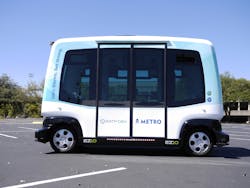Nearly every U.S. city reported a decline in mass transit ridership last year, but there's no consensus on the reason. Some blame too-slow and too-unreliable service, others point to the rise of other options such as ride-sharing, bike-sharing and ride-hailing services like Uber and Lyft. Additional factors likely include falling gas prices, weather change and, rising transit fares. Whatever the reason (or reasons), there are two key steps that any mass transit authority can take to reverse this trend and provide high levels of ridership satisfaction and safety: Implement technologies that collect and analyze data to identify areas for improvement; and embrace other transportation options as part of one holistic transportation infrastructure. Become the Mobility Manager for your City.
Analysis of data from the American Public Transportation Association reveals that between 2014-2016, all but seven of the country's largest urban areas lost riders. Nationwide, ridership declined by 4.5 percent. Only three U.S. cities saw a greater than 1 percent increase in ridership between 2015 and 2016.
Adding more vehicles and stops alone is no longer adequate. Increasing ridership numbers requires leveraging technologies that enable mass transit agencies to evolve from being transportation providers that send buses and trains along predetermined routes to mobility management providers that consider all aspects of their riders’ journeys. That begins with the collection and analysis of information from multiple sources.
RATP Dev operates and maintains all modes of mass transportation, including buses, metros, tramways and rail systems worldwide. We have made installing telematics technologies in all vehicles a priority so we can collect, analyze and use data in real time to do much more than monitor whether a bus reaches a stop at the scheduled time. We monitor factors like driver behavior, vehicle performance, rider demographics and even how the time of day affects ridership levels. This data enables our service providers in France, for example, to make adjustments to vehicle schedules and staffing levels to better meet riders’ expectations and demands.
Take a lesson from the internet and store retail sector: it is impossible to overestimate the importance of always striving to create a better customer experience. That is critical to turning first-time or occasional customers into long-term, loyal brand advocates. The same philosophy applies to mass transit riders. Build long-term loyalty, and you will not only maintain ridership levels, you'll see them rise as happy riders broadcast their high satisfaction across all their social media channels.
That is why technology plays a key role not only in the "back room operations," but also in improving the customer experience. You should strive to be the primary source of information that passengers turn to for all of their transportation options. Provide them with a single view into bus and train arrival times and delays, as well as their options for the last mile, be it a ride-or bike-sharing service, a shuttle bus, or hailing an Uber. If you can make last mile services more accessible, that will have a positive impact on ridership trends..
As more municipal officials move forward with their “smart city” plans, you need to be part of those efforts. RATP Dev strives to offer truly innovative solutions such as TRILOGY, a future-oriented solution based on Big Data and real-time journey monitoring. TRILOGY is already rolled out on the Casablanca tram (Morocco), Valenciennes tram (France), and bus routes in Austin, Texas. Additionally, RATP Dev also works with next-generation technology developers like Connecthings that supply the hardware and software technologies that serve as the foundation for a smart mass transit system.
Consider this scenario: a rider’s bus is delayed, but she’s not in a hurry. She can check the mass transit mobile app on her smartphone for nearby leisure options, like a Starbucks. If she's in a rush, she can view alternative means of transport like Uber or a bike-sharing. That is how to create the a direct connection to the individual passenger on a mass scale.
The collection and analysis of information is critical to any mass transit system operator's ability to make the successful transformation from an operations manager to a mobility management services provider. Beyond implementing the necessary telematics and other technologies, improving passenger satisfaction and safety levels also requires taking a more holistic approach to public transportation. Embrace options you may view as competitors, such as ride-hailing services, and you build loyalty among your riders, even if your services are not options for them to traverse that last mile. Loyal riders become frequent riders, and encourage their friends and family to do the same.
RATP Dev will be hosting in-booth presentations throughout the day on October 10th that will delve more deeply into technological innovation in the field and how the industry can embrace and leverage said innovation to adapt to the industry demands of the future.
Catherine Chardon is the CEO of RATP Dev North America, the North American subsidiary of RATP Dev, one of the largest global transit operators. Prior to becoming CEO of the North American Operations, Catherine was the Deputy Managing Director for the Business Unit of France & Switzerland.

